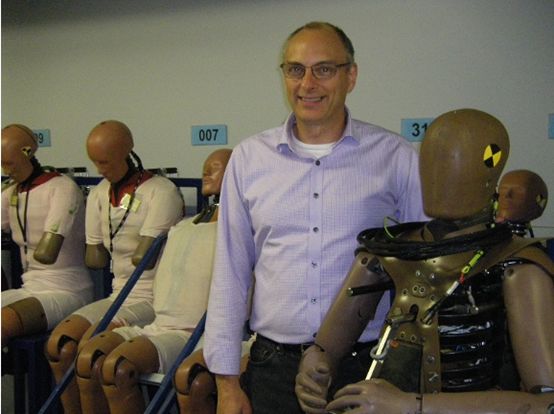 Autoliv工程师正在设计安全气囊和安全带系统,用于自动驾驶车辆的倾斜和放松座椅位置。(图片来源:Autoliv)
Autoliv工程师正在设计安全气囊和安全带系统,用于自动驾驶车辆的倾斜和放松座椅位置。(图片来源:Autoliv) Autoliv副总裁Scott Dershaw身旁的碰撞测试假人(图片来源:Autoliv)
Autoliv副总裁Scott Dershaw身旁的碰撞测试假人(图片来源:Autoliv) 这款由Adient设计的模块化座椅框架包含一个安装在框架上的安全气囊和一个集成的安全带系统。 Autoliv正在与座椅制造商合作,将其安全气囊和安全带系统整合到车辆座椅中。(图片来源:Autoliv)
这款由Adient设计的模块化座椅框架包含一个安装在框架上的安全气囊和一个集成的安全带系统。 Autoliv正在与座椅制造商合作,将其安全气囊和安全带系统整合到车辆座椅中。(图片来源:Autoliv) 安全气囊上的油漆痕迹显示了将测试假人撞到障碍物的后遗症。(图片来源:Autoliv)
安全气囊上的油漆痕迹显示了将测试假人撞到障碍物的后遗症。(图片来源:Autoliv)
在自动驾驶汽车的设计图上,我们常常会看到座椅呈倾斜或朝向后方。奥托立夫公司(Autoliv)致力于为未来的自动驾驶汽车营造安全乘坐环境,对于公司的工程师而言,这些以前看似不可能实现的座椅布置方式,对被动安全保护提出了新的挑战。
这家汽车安全公司的产品研发副总裁E. Scott Dershem此前在位于密歇根州奥本山的技术中心接受了《汽车工程》杂志的采访,他表示:“自动驾驶汽车的被动安全是一个难以解决的复杂问题,这也是为什么我们选择从最基本的场景切入——即坐在稍微倾斜的座椅上的前排乘客遇到正面碰撞。”
安全工程师已经认识到,自动驾驶汽车的座椅布置方式将有别于传统汽车。Dershem表示,“我们面临的难题不是如何达到某个自动驾驶级别,而是如何为车内灵活布置的座椅提供有效的安全保护。”
这就是为什么“以座椅为中心”的安全变得至关重要。Dershem表示,“目前的法律法规已经对安全带的挂点位置做出了强制规定。但是自动驾驶汽车的座椅会发生旋转和倾斜,因此目前的挂点位置已不再是最佳的选择。我们可以通过改变挂点位置的方式来解决该问题,比如前移挂点,让安全带不再扣在腹部的位置。”
安全气囊的封装通常受到座舱配置的影响。如果自动驾驶汽车去除了仪表板或其它传统的座舱配置,那么座椅将是放置气囊的最佳位置。
Dershem说道,“自2014年起,我们就在开发一款叫‘LifeCell’的概念产品,这是一款带有两个充气装置的帘状气囊。”Life Cell安全气囊启动时从座椅内弹出。完全释放后,气囊会包裹住乘客的头部和肩部。Dershem表示,“我们已经改良了这款产品,此前的第一代气囊是不会包住头部的。”
研究人员和工程师正在探讨,当座椅的倾斜角度处于所谓的“正常后倾”角度时,应当如何保护乘客的安全。目前计算机模拟和碰撞假人测试结果表明,此时乘客的头部并不在安全气帘的保护区域内。
Dershem还谈到了乘坐自动驾驶汽车可能会导致的另一个问题,“我们正在讨论是否应该在座椅倾斜时抬高座椅。这样做有两个好处:1. 当发生侧面碰撞时,抬高座椅可以让气帘得以包裹住头部。2. 乘客头部的位置会在车辆的腰线以上,并和车窗重新持平,以预防晕车。”
仿真第一
奥托立夫的被动安全系统测试流程通常从计算机仿真测试开始,然后进行静态测试。静态测试的目的是为了检测安全气囊触发后测试假人的状况。接着是测试假人受到固定障碍物冲击的滑车测试。Dershem表示,“如果我们想要调整一项不完善的技术,通常会需要从源头开始。”最后一步的测试将在实车上进行。
据介绍,奥托立夫的技术人员可能会到2020年才开始进行假人实车碰撞测试。Dershem表示,“一些汽车制造商希望打造自动驾驶汽车接送服务,这些车企很可能会率先开展实车测试。”
当碰撞事故发生时,被动安全系统可以保护乘客的安全。与此同时,这些技术在事故预防中也发挥着重要作用。
Dershem表示,“自动驾驶汽车会采取避撞措施,比如快速变道或紧急刹车,以防止和路面物体发生冲撞。这些物体可能是其它车辆,也可能是行人、骑车者,甚至可能是一头鹿。试想一下,如果座舱布置得像客厅一样,没有一位乘客系着安全带,然后车辆突然以1G的减速度刹车,那么车内肯定会怨声四起。”
Reclined and rotated seating positions are commonly depicted for autonomously driven vehicles. But for the Autoliv engineers tasked with developing occupant safety for tomorrow’s self-driving vehicles, those previously improbable seating positions dictate innovative new passive safety protections.
“Passive safety for autonomous vehicles is a pretty complicated problem to solve, which is why we’re starting out with the simplest scenario: a frontal crash with a front occupant in a partial-recline position,” E. Scott Dershem, Autoliv’s Vice President of Product Development, said in an interview with Automotive Engineering at the safety supplier’s Auburn Hills, Michigan technical center.
Safety engineers know occupants in self-driving vehicles might be seated in unconventional positions. “For us, it’s not really about a particular level of autonomy; it’s more about the level of seating flexibility inside the vehicle,” he said.
That’s why "seat-centric" safety is vital. “There are laws and regulations now as to where seatbelt anchors have to be. But as seats rotate and recline, today’s anchor points aren’t in the optimum location. That issue could be solved with a change in the anchor point, such as moving it further forward to get the seatbelt off the abdomen area,” he offered.
In-cabin features heavily influence the packaging of airbags. But if a self-driving vehicle is without a conventional instrument panel or other traditional cabin fixtures, the seats are the prime packaging locale for airbags.
“We’ve been working on our Life Cell concept since 2014. It’s a curtain airbag with two inflators,” said Dershem. The Life Cell airbag deploys from the seat and when fully deployed essentially envelopes the occupant’s head and shoulders. “The product has evolved. Our first-generation version didn’t go over the occupant’s head,” he said.
Researchers and engineers are looking for ways to address what happens during a so-called ‘normal-recline seating position.’ Computer simulations and testing with crash dummies show that the occupant’s head won’t be within the curtain airbag’s protection zone when seated in the ‘normal recline’ position.
“We’ve been talking about raising the seat up as you recline. That does two things: It gets the head back into the curtain area during a side impact. It also puts the head above the vehicle’s belt line and back into the window area so the occupant doesn’t get motion sickness,” he said, referring to a malady that’s possible when riding in an autonomously-driven vehicle.
Simulation first
Autoliv’s typical testing process for passive safety systems starts with computer simulations. That’s followed by static testing to determine what happens to crash test dummies when airbags deploy and sled crashes with crash-test dummies into fixed barriers. “It’s not uncommon to go back to the beginning if we want to tweak an under-development technology,” he said. The final testing stage involves actual vehicles.
Autoliv technicians likely won’t conduct crash tests with dummies inside physical vehicles before the 2020 timeframe. “Some vehicle manufacturers are looking to do autonomous mobility as a delivery service, so those are likely to be first in-line for actual vehicle testing,” he said.
Passive safety systems offer protection during a vehicle crash, but those same technologies could be vital in instances of accident avoidance.
“There will be evasive maneuvers by autonomously driven vehicles that prompt a quick lane change or emergency braking to avoid a collision with another vehicle, pedestrian, bicyclist, deer, or some other object,” said Dershem. “Imagine if the occupants are in ‘living room’ seating position and the vehicle does 1G braking and no one is belted. It’s going to get ornery inside that vehicle.”
Author: Kami Buchholz
Source: SAE Automotive Engineering Magazine
等级
打分
- 2分
- 4分
- 6分
- 8分
- 10分
平均分
